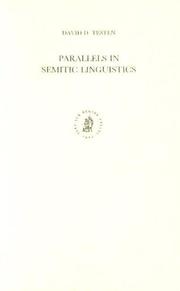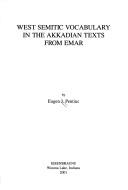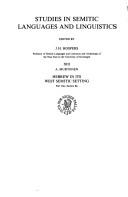| Listing 1 - 8 of 8 |
Sort by
|
Book
ISBN: 9789004348547 9789004348554 9004348557 9004348549 Year: 2018 Publisher: Leiden : Brill,
Abstract | Keywords | Export | Availability | Bookmark
 Loading...
Loading...Choose an application
- Reference Manager
- EndNote
- RefWorks (Direct export to RefWorks)
In 'Historical Aspects of Standard Negation in Semitic' Ambjörn Sjörs investigates the grammar of standard negation in a wide selection of Semitic languages. The bulk of the investigation consists of a detailed analysis of negative constructions and is based on a first-hand examination of the examples in context. The main issues that are investigated in the book relate to the historical change of the expression of verbal negation in Semitic and the reconstruction of the genealogical relationship of negative constructions. It shows how negation is constantly renewed from the reanalysis of emphatic negative constructions, and how structural asymmetries between negative constructions and the corresponding affirmative constructions arise from the linguistically conservative nature of negative vis-a-vis affirmative clauses.
Semitic languages --- Afroasiatic languages --- Negatives. --- Langues sémitiques --- Négation (linguistique) --- Langues sémitiques --- Negatives --- Négation (linguistique)

ISBN: 9004348425 9004109730 Year: 1998 Publisher: Leiden ; Boston : Brill,
Abstract | Keywords | Export | Availability | Bookmark
 Loading...
Loading...Choose an application
- Reference Manager
- EndNote
- RefWorks (Direct export to RefWorks)
This linguistic study is concerned with the role of the emphasizing particle la- (known as lām al-ta'kīd) in the grammatical traditions of Classical Arabic, as well as with the question of the historical relationship connecting this particle to a set of elements in several other Semitic languages showing comparable forms and functions. Although these particles have hitherto seemed to defy a coherent reconstruction, the very complexity of the data to which they attest proves to provide a key to their interpretation. They represent a critical first step in the refining of our understanding of the history of the Semitic sonorant phonemes.
Arabic language --- Semitic languages --- Afroasiatic languages --- Particles. --- Arabe (langue) --- Langues sémitiques. --- Particules (linguistique) --- Langues sémitiques.
Book
ISBN: 9782351595015 Year: 1993 Publisher: Presses de l’Ifpo
Abstract | Keywords | Export | Availability | Bookmark
 Loading...
Loading...Choose an application
- Reference Manager
- EndNote
- RefWorks (Direct export to RefWorks)
Depuis la fin des années 1970, la linguistique a profondément évolué, et des travaux portant sur l'arabe, les autres langues sémitiques et le chamito-sémitique ont grandement contribué à cette évolution. Longtemps limitée à une approche empiriciste, la sociolinguistique arabe tente dorénavant, à partir d'une réflexion sur son propre objet, de mettre en relation recherche empirique et recherche théorique dans l'étude de l'arabe parlé formel. Réalisé sous la direction de Georges Bohas, Développements récents en linguistique arabe et sémitique a pour projet d'esquisser un état des recherches en cours, dans les domaines de la phonologie, de la morphologie et de la syntaxe. Après deux chapitres généraux (« Le PCO et la structure des racines », « Diverses conceptions de la morphologie arabe »), l’ouvrage se divise en cinq articles abordant différents champs de recherche de la linguistique arabe : « Accentuation et effacements vocaliques », « Voyelles centrales, noyaux vides et statut de la longueur vocalique dans deux branches du sémitique », « Contribution à l'étude de l'arabe parlé formel », « Un témoin fossile du Kitāb de Sībawayhi » et « Une lecture énonciative du Kitāb de Sībawayhi ».
Languages & Literatures --- Middle Eastern Languages & Literatures --- langues sémitiques --- langue arabe --- linguistique
Book
ISBN: 9782847880762 2847880763 2847884327 Year: 2007 Publisher: Lyon ENS
Abstract | Keywords | Export | Availability | Bookmark
 Loading...
Loading...Choose an application
- Reference Manager
- EndNote
- RefWorks (Direct export to RefWorks)
Lexicology. Semantics --- Grammar --- Semitic languages --- Langues sémitiques --- Morphology. --- Word formation. --- Roots. --- Lexicology. --- Morphologie --- Formation des mots --- Racines --- Lexicologie --- Langues sémitiques

ISBN: 1575069105 9004369872 9789004369870 9781575069104 Year: 2018 Publisher: [Place of publication not identified]
Abstract | Keywords | Export | Availability | Bookmark
 Loading...
Loading...Choose an application
- Reference Manager
- EndNote
- RefWorks (Direct export to RefWorks)
Part 1 of this study is a glossary with comparative analysis of non-normative Akkadian forms, Hittite and Hurrian words, West Semitic lexemes, and words of uncertain origin, with special attention given to the West Semitic forms. Part 2 consists of grammatical observations pertaining to the West Semitic forms, under the headings orthography, phonology, and morphology.
Semitic languages, West --- Akkadian language --- Langues sémitiques occidentales --- Akkadien (Langue) --- Glossaries, vocabularies, etc. --- Grammar --- Texts --- Glossaires, vocabulaires, etc --- Grammaire --- Textes --- Emar (Extinct city) --- Emar (Ville ancienne) --- Foreign words and phrases --- Semitic, West. --- Grammar. --- Emar (Extinct city). --- Langues sémitiques occidentales --- Semitic languages, West. --- West Semitic languages --- Semitic languages --- Syria --- Emar --- Middle East --- Emar (Ancient city) --- Maskanah Site (Syria) --- Meskéné Site (Syria) --- Antiquities --- Langues sémitiques occidentales septentrionales --- Akkadien (langue) --- Emar (ville ancienne) --- Glossaires, vocabulaires, etc. --- Emprunts sémitiques

ISSN: 00818461 ISBN: 9004088180 9789004088184 9004348263 9789004348264 9004088100 Year: 1989 Volume: 14 Publisher: Leiden Brill
Abstract | Keywords | Export | Availability | Bookmark
 Loading...
Loading...Choose an application
- Reference Manager
- EndNote
- RefWorks (Direct export to RefWorks)
Grammar --- Semitic languages --- Arabic language --- Langues sémitiques --- Arabe (Langue) --- Grammar, Comparative --- Grammaire comparée --- Grammaire --- Voice. --- Passief. --- Causatieven. --- Semitische talen. --- Diachronische morfologie. --- Genus verbi --- Kontrastive Morphologie --- Arabe (langue) --- Phonétique. --- Voix. --- Voice --- Semitische Sprachen --- Arabisch --- Genus verbi. --- Kontrastive Morphologie. --- Arabisch. --- Semitische Sprachen. --- Langues sémitiques --- Grammaire comparée --- Semitic languages - Voice. --- Arabic language - Voice. --- Afroasiatic languages

ISBN: 9004080643 9004348298 9789004348295 9789004080645 Year: 1988 Volume: vol 13 Section Ba Publisher: Leiden
Abstract | Keywords | Export | Availability | Bookmark
 Loading...
Loading...Choose an application
- Reference Manager
- EndNote
- RefWorks (Direct export to RefWorks)
Comparative linguistics --- Langues semitiques du Nord-ouest --- Linguistique comparée --- Semitic languages [Northwest ] --- Semitische talen [Noordwest- ] --- Taalwetenschap [Vergelijkende ] --- Hebrew language --- Dialects --- Roots --- Dictionaries --- Comparative linguistics. --- Semitic languages, West. --- Names in rabbinical literature --- Names in the Bible --- Jewish language --- Jews --- Semitic languages, Northwest --- Names in the Talmud --- Rabbinical literature --- Historical linguistics --- West Semitic languages --- Semitic languages --- Dialects. --- Morphology. --- Phonology. --- Languages
Book
ISBN: 1575068931 9781575068930 9781575062808 1575062801 Year: 2021 Publisher: University Park, PA
Abstract | Keywords | Export | Availability | Bookmark
 Loading...
Loading...Choose an application
- Reference Manager
- EndNote
- RefWorks (Direct export to RefWorks)
Hittite culture of the second millennium B.C.E. was strongly influenced by Mesopotamian culture, in part through the mediation of the peripheral cuneiform civilizations of northern Syria, in part through direct contact with Babylonia and Assyria. The text edited here (CTH 718) presents an extreme example of this cultural impact, featuring incantations in the Akkadian language (Hittite babilili) embedded within a ceremony set forth in the Hittite tongue. This ritual program has therefore become known to scholars as the "babilili-ritual." With almost 400 preserved lines, this ceremony is one of the longest religious compositions recovered from the Hittite capital, and there are indications that a significant additional portion has been lost. The divine figure to whom the rite is addressed is Pirinkir, a variety of the well-known Ishtar of Mesopotamia. Its purpose seems to be the elimination of the sins of a member of the royal family. Many of the ritual activities and offering materials employed here are characteristic of the cult practice of the Classical Cilician region known as Kizzuwatna, which was introduced into the central Hittite realm during the final two centuries of the state's existence. Nonetheless, the Akkadian of the incantations is neither the Akkadian employed in the Hurrian-influenced area of Syria and eastern Anatolia nor that otherwise known from the Hittite royal archives; rather, it is closer to the language of the later Old Babylonian period, even if no precise Mesopotamian forerunners can yet be identified.
Hittites --- Akkadian language --- Religion. --- Kizzuwatna (Cilicia) --- Akkadian language. --- Akkadien (langue) --- Religion hittite. --- Accadian language --- Assyrian language --- Assyro-Babylonian language --- Babylonian language --- Semitic languages --- Religion, Primitive --- Atheism --- Irreligion --- Religions --- Theology --- Textes. --- Texts. --- Kizzuwatna (royaume) --- Histoire --- Sources. --- Mythologie hittite --- Temples hittites --- Dieux hittites --- Accadien (langue) --- Assyrien (langue) --- Assyro-babylonien (langue) --- Babylonien (langue) --- Sémitique oriental (langue) --- Akkadien --- Correspondance akkadienne --- Dictionnaires akkadiens --- Emprunts akkadiens --- Glossaires et lexiques akkadiens --- Grammaire comparée --- Hymnes akkadiens --- Incantations akkadiennes --- Incantations assyro-babyloniennes --- Inscriptions akkadiennes --- Littérature assyro-babylonienne --- Noms de personnes akkadiens --- Noms géographiques akkadiens --- Philologie akkadienne --- Langues sémitiques --- Religion --- langue) -- Vocabulaire --- Kizzuwadna (Royaume) --- Kizzuwatna (Royaume) --- Asie Mineure --- Kizzuwatna (Kingdom)
| Listing 1 - 8 of 8 |
Sort by
|

 Search
Search Feedback
Feedback About UniCat
About UniCat  Help
Help News
News